Pharmaceutical Fraud: Corporate Responsibility Analysis Report
VerifiedAdded on 2023/06/12
|29
|13800
|115
Report
AI Summary
This report delves into the critical intersection of corporate responsibility and pharmaceutical fraud, particularly within the American healthcare system. It highlights the substantial financial impact of healthcare fraud, estimated at $80 billion annually, and the various schemes employed by pharmaceutical manufacturers and distributors, including GMP violations, off-label marketing, and kickbacks. The report discusses the role of the False Claims Act (FCA) in prosecuting fraud, emphasizing its qui tam provisions that empower whistle-blowers to initiate legal action. Amendments like the Fraud Enforcement and Recovery Act of 2009 and the Patient Protection and Affordable Care Act of 2010 are examined for their impact on strengthening fraud-fighting measures. The report underscores the importance of whistle-blowers in uncovering fraud and the need for increased transparency and trust within the pharmaceutical industry to preserve its historical contributions to health.
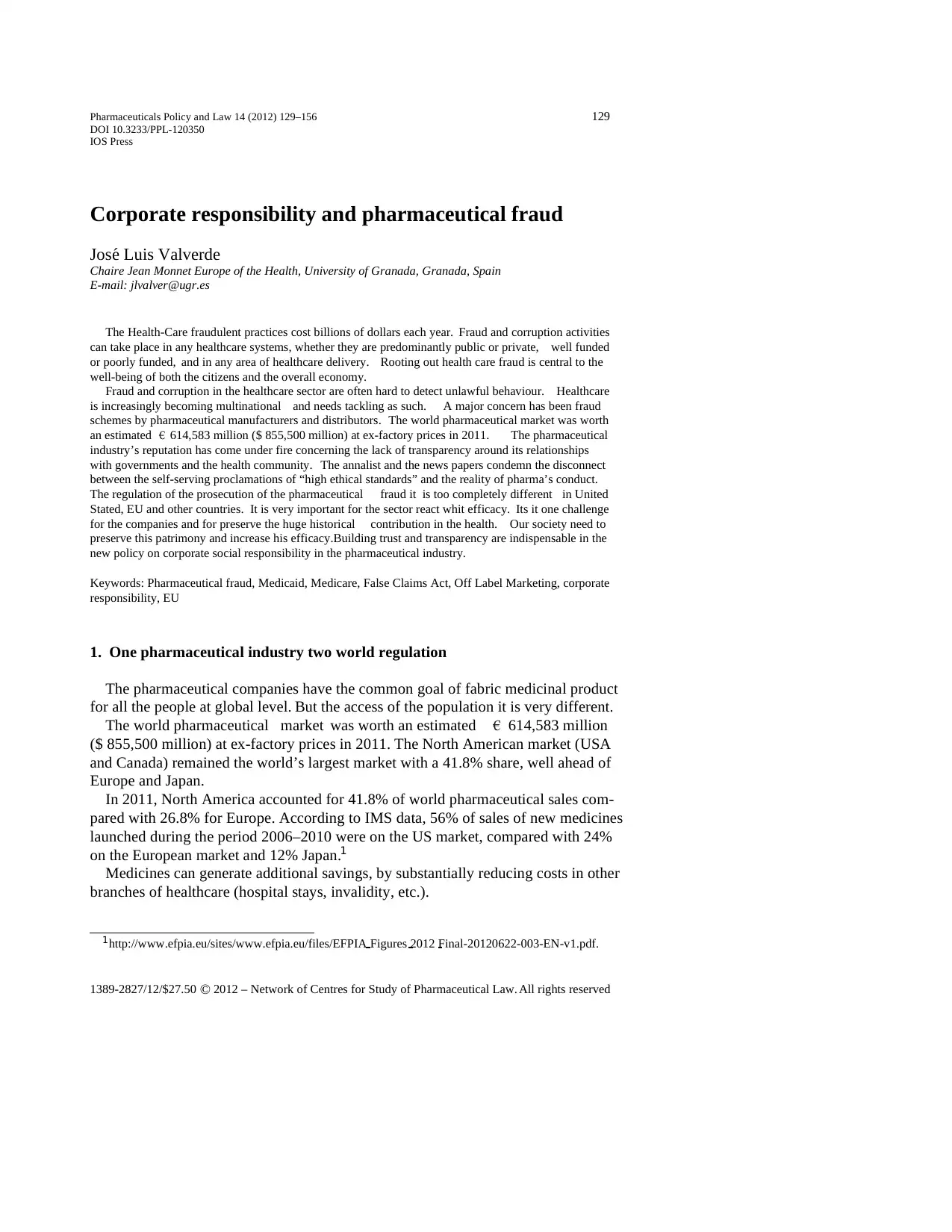
Pharmaceuticals Policy and Law 14 (2012) 129–156 129
DOI 10.3233/PPL-120350
IOS Press
Corporate responsibility and pharmaceutical fraud
Jos´e Luis Valverde
Chaire Jean Monnet Europe of the Health, University of Granada, Granada, Spain
E-mail: jlvalver@ugr.es
The Health-Care fraudulent practices cost billions of dollars each year. Fraud and corruption activities
can take place in any healthcare systems, whether they are predominantly public or private, well funded
or poorly funded, and in any area of healthcare delivery. Rooting out health care fraud is central to the
well-being of both the citizens and the overall economy.
Fraud and corruption in the healthcare sector are often hard to detect unlawful behaviour. Healthcare
is increasingly becoming multinational and needs tackling as such. A major concern has been fraud
schemes by pharmaceutical manufacturers and distributors. The world pharmaceutical market was worth
an estimated 614,583 million ($ 855,500 million) at ex-factory prices in 2011. The pharmaceutical
industry’s reputation has come under fire concerning the lack of transparency around its relationships
with governments and the health community. The annalist and the news papers condemn the disconnect
between the self-serving proclamations of “high ethical standards” and the reality of pharma’s conduct.
The regulation of the prosecution of the pharmaceutical fraud it is too completely different in United
Stated, EU and other countries. It is very important for the sector react whit efficacy. Its it one challenge
for the companies and for preserve the huge historical contribution in the health. Our society need to
preserve this patrimony and increase his efficacy.Building trust and transparency are indispensable in the
new policy on corporate social responsibility in the pharmaceutical industry.
Keywords: Pharmaceutical fraud, Medicaid, Medicare, False Claims Act, Off Label Marketing, corporate
responsibility, EU
1. One pharmaceutical industry two world regulation
The pharmaceutical companies have the common goal of fabric medicinal product
for all the people at global level. But the access of the population it is very different.
The world pharmaceutical market was worth an estimated 614,583 million
($ 855,500 million) at ex-factory prices in 2011. The North American market (USA
and Canada) remained the world’s largest market with a 41.8% share, well ahead of
Europe and Japan.
In 2011, North America accounted for 41.8% of world pharmaceutical sales com-
pared with 26.8% for Europe. According to IMS data, 56% of sales of new medicines
launched during the period 2006–2010 were on the US market, compared with 24%
on the European market and 12% Japan.1
Medicines can generate additional savings, by substantially reducing costs in other
branches of healthcare (hospital stays, invalidity, etc.).
1http://www.efpia.eu/sites/www.efpia.eu/files/EFPIA Figures 2012 Final-20120622-003-EN-v1.pdf.
1389-2827/12/$27.50 2012 – Network of Centres for Study of Pharmaceutical Law. All rights reserved
DOI 10.3233/PPL-120350
IOS Press
Corporate responsibility and pharmaceutical fraud
Jos´e Luis Valverde
Chaire Jean Monnet Europe of the Health, University of Granada, Granada, Spain
E-mail: jlvalver@ugr.es
The Health-Care fraudulent practices cost billions of dollars each year. Fraud and corruption activities
can take place in any healthcare systems, whether they are predominantly public or private, well funded
or poorly funded, and in any area of healthcare delivery. Rooting out health care fraud is central to the
well-being of both the citizens and the overall economy.
Fraud and corruption in the healthcare sector are often hard to detect unlawful behaviour. Healthcare
is increasingly becoming multinational and needs tackling as such. A major concern has been fraud
schemes by pharmaceutical manufacturers and distributors. The world pharmaceutical market was worth
an estimated 614,583 million ($ 855,500 million) at ex-factory prices in 2011. The pharmaceutical
industry’s reputation has come under fire concerning the lack of transparency around its relationships
with governments and the health community. The annalist and the news papers condemn the disconnect
between the self-serving proclamations of “high ethical standards” and the reality of pharma’s conduct.
The regulation of the prosecution of the pharmaceutical fraud it is too completely different in United
Stated, EU and other countries. It is very important for the sector react whit efficacy. Its it one challenge
for the companies and for preserve the huge historical contribution in the health. Our society need to
preserve this patrimony and increase his efficacy.Building trust and transparency are indispensable in the
new policy on corporate social responsibility in the pharmaceutical industry.
Keywords: Pharmaceutical fraud, Medicaid, Medicare, False Claims Act, Off Label Marketing, corporate
responsibility, EU
1. One pharmaceutical industry two world regulation
The pharmaceutical companies have the common goal of fabric medicinal product
for all the people at global level. But the access of the population it is very different.
The world pharmaceutical market was worth an estimated 614,583 million
($ 855,500 million) at ex-factory prices in 2011. The North American market (USA
and Canada) remained the world’s largest market with a 41.8% share, well ahead of
Europe and Japan.
In 2011, North America accounted for 41.8% of world pharmaceutical sales com-
pared with 26.8% for Europe. According to IMS data, 56% of sales of new medicines
launched during the period 2006–2010 were on the US market, compared with 24%
on the European market and 12% Japan.1
Medicines can generate additional savings, by substantially reducing costs in other
branches of healthcare (hospital stays, invalidity, etc.).
1http://www.efpia.eu/sites/www.efpia.eu/files/EFPIA Figures 2012 Final-20120622-003-EN-v1.pdf.
1389-2827/12/$27.50 2012 – Network of Centres for Study of Pharmaceutical Law. All rights reserved
Paraphrase This Document
Need a fresh take? Get an instant paraphrase of this document with our AI Paraphraser
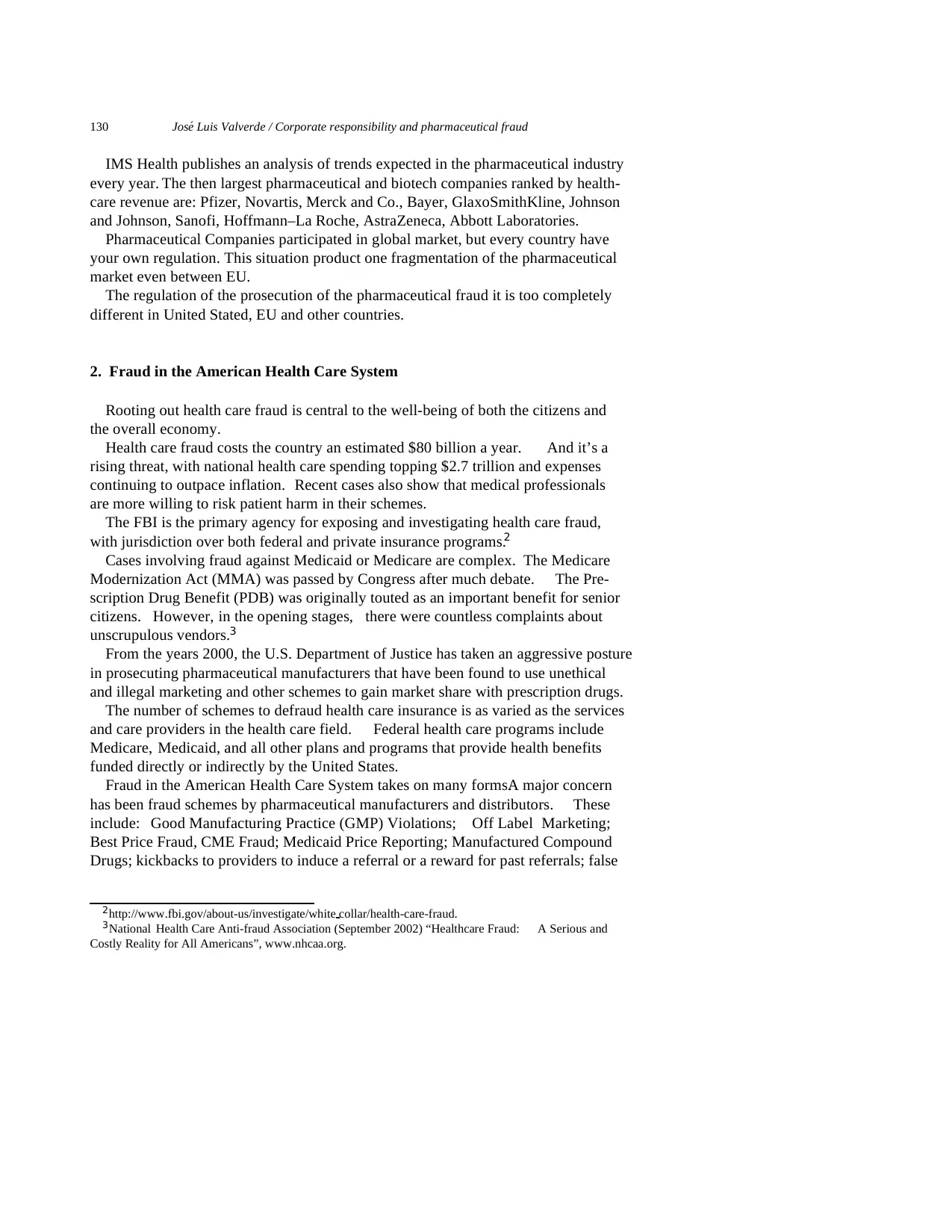
130 Jos´e Luis Valverde / Corporate responsibility and pharmaceutical fraud
IMS Health publishes an analysis of trends expected in the pharmaceutical industry
every year. The then largest pharmaceutical and biotech companies ranked by health-
care revenue are: Pfizer, Novartis, Merck and Co., Bayer, GlaxoSmithKline, Johnson
and Johnson, Sanofi, Hoffmann–La Roche, AstraZeneca, Abbott Laboratories.
Pharmaceutical Companies participated in global market, but every country have
your own regulation. This situation product one fragmentation of the pharmaceutical
market even between EU.
The regulation of the prosecution of the pharmaceutical fraud it is too completely
different in United Stated, EU and other countries.
2. Fraud in the American Health Care System
Rooting out health care fraud is central to the well-being of both the citizens and
the overall economy.
Health care fraud costs the country an estimated $80 billion a year. And it’s a
rising threat, with national health care spending topping $2.7 trillion and expenses
continuing to outpace inflation. Recent cases also show that medical professionals
are more willing to risk patient harm in their schemes.
The FBI is the primary agency for exposing and investigating health care fraud,
with jurisdiction over both federal and private insurance programs.2
Cases involving fraud against Medicaid or Medicare are complex. The Medicare
Modernization Act (MMA) was passed by Congress after much debate. The Pre-
scription Drug Benefit (PDB) was originally touted as an important benefit for senior
citizens. However, in the opening stages, there were countless complaints about
unscrupulous vendors.3
From the years 2000, the U.S. Department of Justice has taken an aggressive posture
in prosecuting pharmaceutical manufacturers that have been found to use unethical
and illegal marketing and other schemes to gain market share with prescription drugs.
The number of schemes to defraud health care insurance is as varied as the services
and care providers in the health care field. Federal health care programs include
Medicare, Medicaid, and all other plans and programs that provide health benefits
funded directly or indirectly by the United States.
Fraud in the American Health Care System takes on many forms.A major concern
has been fraud schemes by pharmaceutical manufacturers and distributors. These
include: Good Manufacturing Practice (GMP) Violations; Off Label Marketing;
Best Price Fraud, CME Fraud; Medicaid Price Reporting; Manufactured Compound
Drugs; kickbacks to providers to induce a referral or a reward for past referrals; false
2http://www.fbi.gov/about-us/investigate/white collar/health-care-fraud.
3National Health Care Anti-fraud Association (September 2002) “Healthcare Fraud: A Serious and
Costly Reality for All Americans”, www.nhcaa.org.
IMS Health publishes an analysis of trends expected in the pharmaceutical industry
every year. The then largest pharmaceutical and biotech companies ranked by health-
care revenue are: Pfizer, Novartis, Merck and Co., Bayer, GlaxoSmithKline, Johnson
and Johnson, Sanofi, Hoffmann–La Roche, AstraZeneca, Abbott Laboratories.
Pharmaceutical Companies participated in global market, but every country have
your own regulation. This situation product one fragmentation of the pharmaceutical
market even between EU.
The regulation of the prosecution of the pharmaceutical fraud it is too completely
different in United Stated, EU and other countries.
2. Fraud in the American Health Care System
Rooting out health care fraud is central to the well-being of both the citizens and
the overall economy.
Health care fraud costs the country an estimated $80 billion a year. And it’s a
rising threat, with national health care spending topping $2.7 trillion and expenses
continuing to outpace inflation. Recent cases also show that medical professionals
are more willing to risk patient harm in their schemes.
The FBI is the primary agency for exposing and investigating health care fraud,
with jurisdiction over both federal and private insurance programs.2
Cases involving fraud against Medicaid or Medicare are complex. The Medicare
Modernization Act (MMA) was passed by Congress after much debate. The Pre-
scription Drug Benefit (PDB) was originally touted as an important benefit for senior
citizens. However, in the opening stages, there were countless complaints about
unscrupulous vendors.3
From the years 2000, the U.S. Department of Justice has taken an aggressive posture
in prosecuting pharmaceutical manufacturers that have been found to use unethical
and illegal marketing and other schemes to gain market share with prescription drugs.
The number of schemes to defraud health care insurance is as varied as the services
and care providers in the health care field. Federal health care programs include
Medicare, Medicaid, and all other plans and programs that provide health benefits
funded directly or indirectly by the United States.
Fraud in the American Health Care System takes on many forms.A major concern
has been fraud schemes by pharmaceutical manufacturers and distributors. These
include: Good Manufacturing Practice (GMP) Violations; Off Label Marketing;
Best Price Fraud, CME Fraud; Medicaid Price Reporting; Manufactured Compound
Drugs; kickbacks to providers to induce a referral or a reward for past referrals; false
2http://www.fbi.gov/about-us/investigate/white collar/health-care-fraud.
3National Health Care Anti-fraud Association (September 2002) “Healthcare Fraud: A Serious and
Costly Reality for All Americans”, www.nhcaa.org.
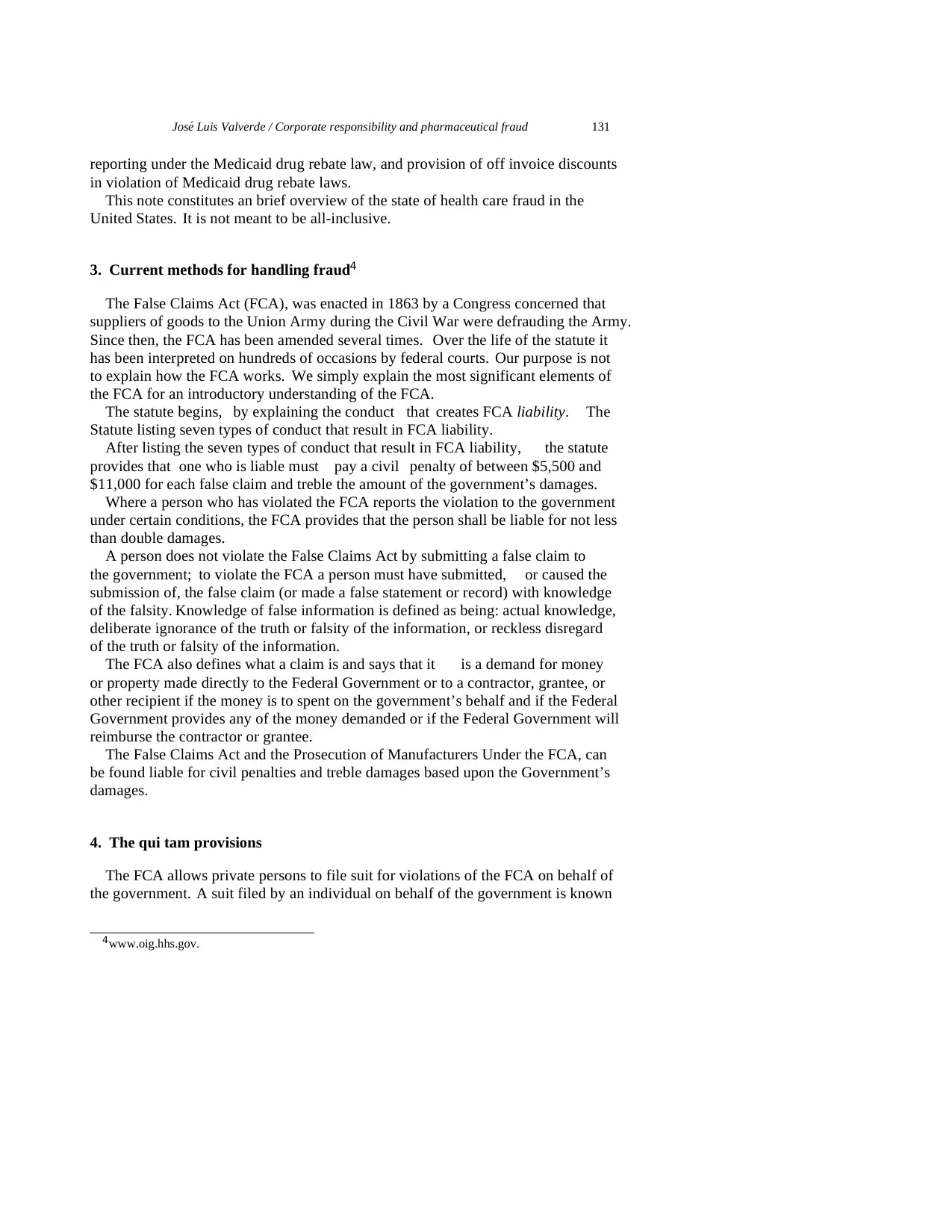
Jos´e Luis Valverde / Corporate responsibility and pharmaceutical fraud 131
reporting under the Medicaid drug rebate law, and provision of off invoice discounts
in violation of Medicaid drug rebate laws.
This note constitutes an brief overview of the state of health care fraud in the
United States. It is not meant to be all-inclusive.
3. Current methods for handling fraud4
The False Claims Act (FCA), was enacted in 1863 by a Congress concerned that
suppliers of goods to the Union Army during the Civil War were defrauding the Army.
Since then, the FCA has been amended several times. Over the life of the statute it
has been interpreted on hundreds of occasions by federal courts. Our purpose is not
to explain how the FCA works. We simply explain the most significant elements of
the FCA for an introductory understanding of the FCA.
The statute begins, by explaining the conduct that creates FCA liability. The
Statute listing seven types of conduct that result in FCA liability.
After listing the seven types of conduct that result in FCA liability, the statute
provides that one who is liable must pay a civil penalty of between $5,500 and
$11,000 for each false claim and treble the amount of the government’s damages.
Where a person who has violated the FCA reports the violation to the government
under certain conditions, the FCA provides that the person shall be liable for not less
than double damages.
A person does not violate the False Claims Act by submitting a false claim to
the government; to violate the FCA a person must have submitted, or caused the
submission of, the false claim (or made a false statement or record) with knowledge
of the falsity. Knowledge of false information is defined as being: actual knowledge,
deliberate ignorance of the truth or falsity of the information, or reckless disregard
of the truth or falsity of the information.
The FCA also defines what a claim is and says that it is a demand for money
or property made directly to the Federal Government or to a contractor, grantee, or
other recipient if the money is to spent on the government’s behalf and if the Federal
Government provides any of the money demanded or if the Federal Government will
reimburse the contractor or grantee.
The False Claims Act and the Prosecution of Manufacturers Under the FCA, can
be found liable for civil penalties and treble damages based upon the Government’s
damages.
4. The qui tam provisions
The FCA allows private persons to file suit for violations of the FCA on behalf of
the government. A suit filed by an individual on behalf of the government is known
4www.oig.hhs.gov.
reporting under the Medicaid drug rebate law, and provision of off invoice discounts
in violation of Medicaid drug rebate laws.
This note constitutes an brief overview of the state of health care fraud in the
United States. It is not meant to be all-inclusive.
3. Current methods for handling fraud4
The False Claims Act (FCA), was enacted in 1863 by a Congress concerned that
suppliers of goods to the Union Army during the Civil War were defrauding the Army.
Since then, the FCA has been amended several times. Over the life of the statute it
has been interpreted on hundreds of occasions by federal courts. Our purpose is not
to explain how the FCA works. We simply explain the most significant elements of
the FCA for an introductory understanding of the FCA.
The statute begins, by explaining the conduct that creates FCA liability. The
Statute listing seven types of conduct that result in FCA liability.
After listing the seven types of conduct that result in FCA liability, the statute
provides that one who is liable must pay a civil penalty of between $5,500 and
$11,000 for each false claim and treble the amount of the government’s damages.
Where a person who has violated the FCA reports the violation to the government
under certain conditions, the FCA provides that the person shall be liable for not less
than double damages.
A person does not violate the False Claims Act by submitting a false claim to
the government; to violate the FCA a person must have submitted, or caused the
submission of, the false claim (or made a false statement or record) with knowledge
of the falsity. Knowledge of false information is defined as being: actual knowledge,
deliberate ignorance of the truth or falsity of the information, or reckless disregard
of the truth or falsity of the information.
The FCA also defines what a claim is and says that it is a demand for money
or property made directly to the Federal Government or to a contractor, grantee, or
other recipient if the money is to spent on the government’s behalf and if the Federal
Government provides any of the money demanded or if the Federal Government will
reimburse the contractor or grantee.
The False Claims Act and the Prosecution of Manufacturers Under the FCA, can
be found liable for civil penalties and treble damages based upon the Government’s
damages.
4. The qui tam provisions
The FCA allows private persons to file suit for violations of the FCA on behalf of
the government. A suit filed by an individual on behalf of the government is known
4www.oig.hhs.gov.
⊘ This is a preview!⊘
Do you want full access?
Subscribe today to unlock all pages.

Trusted by 1+ million students worldwide
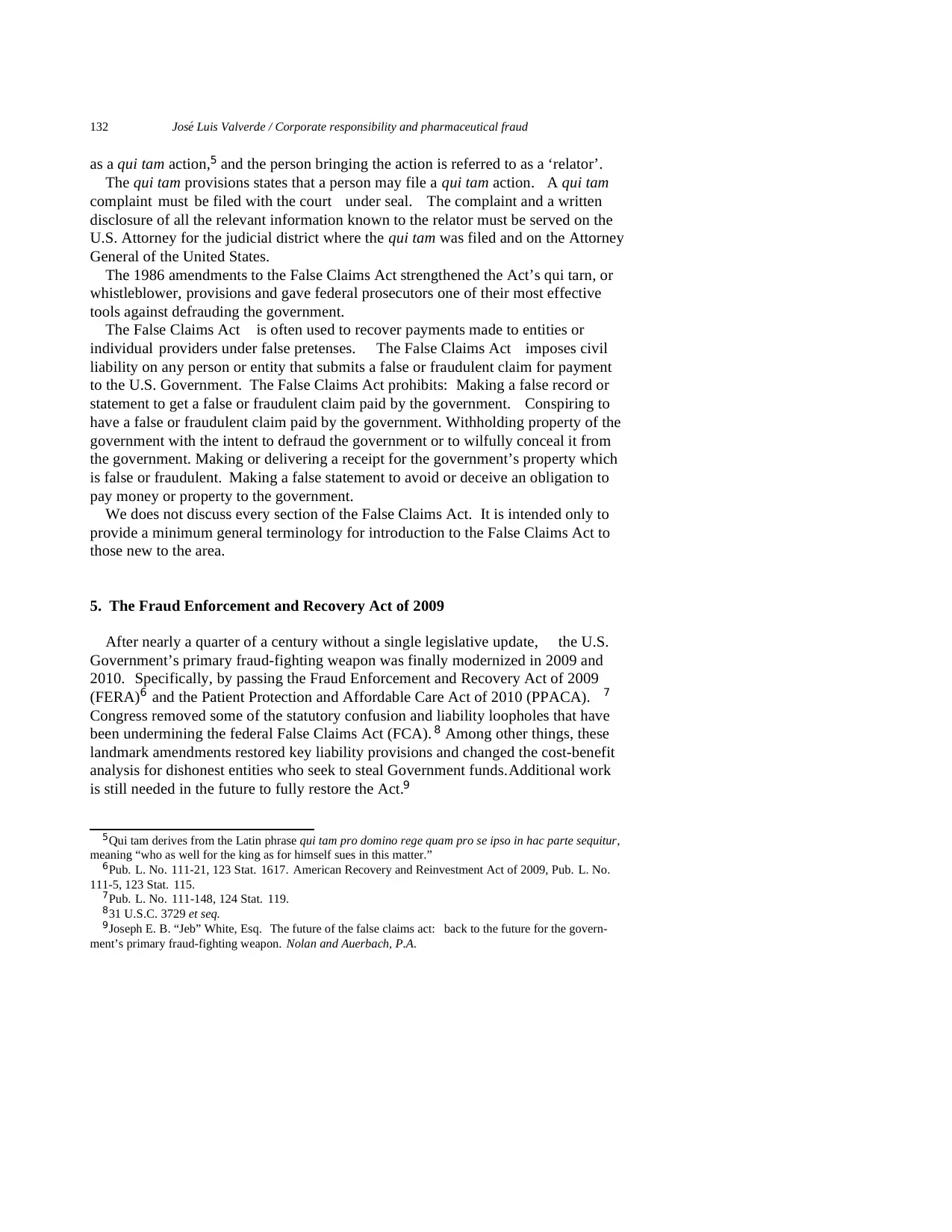
132 Jos´e Luis Valverde / Corporate responsibility and pharmaceutical fraud
as a qui tam action,5 and the person bringing the action is referred to as a ‘relator’.
The qui tam provisions states that a person may file a qui tam action. A qui tam
complaint must be filed with the court under seal. The complaint and a written
disclosure of all the relevant information known to the relator must be served on the
U.S. Attorney for the judicial district where the qui tam was filed and on the Attorney
General of the United States.
The 1986 amendments to the False Claims Act strengthened the Act’s qui tarn, or
whistleblower, provisions and gave federal prosecutors one of their most effective
tools against defrauding the government.
The False Claims Act is often used to recover payments made to entities or
individual providers under false pretenses. The False Claims Act imposes civil
liability on any person or entity that submits a false or fraudulent claim for payment
to the U.S. Government. The False Claims Act prohibits: Making a false record or
statement to get a false or fraudulent claim paid by the government. Conspiring to
have a false or fraudulent claim paid by the government. Withholding property of the
government with the intent to defraud the government or to wilfully conceal it from
the government. Making or delivering a receipt for the government’s property which
is false or fraudulent. Making a false statement to avoid or deceive an obligation to
pay money or property to the government.
We does not discuss every section of the False Claims Act. It is intended only to
provide a minimum general terminology for introduction to the False Claims Act to
those new to the area.
5. The Fraud Enforcement and Recovery Act of 2009
After nearly a quarter of a century without a single legislative update, the U.S.
Government’s primary fraud-fighting weapon was finally modernized in 2009 and
2010. Specifically, by passing the Fraud Enforcement and Recovery Act of 2009
(FERA)6 and the Patient Protection and Affordable Care Act of 2010 (PPACA). 7
Congress removed some of the statutory confusion and liability loopholes that have
been undermining the federal False Claims Act (FCA). 8 Among other things, these
landmark amendments restored key liability provisions and changed the cost-benefit
analysis for dishonest entities who seek to steal Government funds.Additional work
is still needed in the future to fully restore the Act.9
5Qui tam derives from the Latin phrase qui tam pro domino rege quam pro se ipso in hac parte sequitur,
meaning “who as well for the king as for himself sues in this matter.”
6Pub. L. No. 111-21, 123 Stat. 1617. American Recovery and Reinvestment Act of 2009, Pub. L. No.
111-5, 123 Stat. 115.
7Pub. L. No. 111-148, 124 Stat. 119.
831 U.S.C. 3729 et seq.
9Joseph E. B. “Jeb” White, Esq. The future of the false claims act: back to the future for the govern-
ment’s primary fraud-fighting weapon. Nolan and Auerbach, P.A.
as a qui tam action,5 and the person bringing the action is referred to as a ‘relator’.
The qui tam provisions states that a person may file a qui tam action. A qui tam
complaint must be filed with the court under seal. The complaint and a written
disclosure of all the relevant information known to the relator must be served on the
U.S. Attorney for the judicial district where the qui tam was filed and on the Attorney
General of the United States.
The 1986 amendments to the False Claims Act strengthened the Act’s qui tarn, or
whistleblower, provisions and gave federal prosecutors one of their most effective
tools against defrauding the government.
The False Claims Act is often used to recover payments made to entities or
individual providers under false pretenses. The False Claims Act imposes civil
liability on any person or entity that submits a false or fraudulent claim for payment
to the U.S. Government. The False Claims Act prohibits: Making a false record or
statement to get a false or fraudulent claim paid by the government. Conspiring to
have a false or fraudulent claim paid by the government. Withholding property of the
government with the intent to defraud the government or to wilfully conceal it from
the government. Making or delivering a receipt for the government’s property which
is false or fraudulent. Making a false statement to avoid or deceive an obligation to
pay money or property to the government.
We does not discuss every section of the False Claims Act. It is intended only to
provide a minimum general terminology for introduction to the False Claims Act to
those new to the area.
5. The Fraud Enforcement and Recovery Act of 2009
After nearly a quarter of a century without a single legislative update, the U.S.
Government’s primary fraud-fighting weapon was finally modernized in 2009 and
2010. Specifically, by passing the Fraud Enforcement and Recovery Act of 2009
(FERA)6 and the Patient Protection and Affordable Care Act of 2010 (PPACA). 7
Congress removed some of the statutory confusion and liability loopholes that have
been undermining the federal False Claims Act (FCA). 8 Among other things, these
landmark amendments restored key liability provisions and changed the cost-benefit
analysis for dishonest entities who seek to steal Government funds.Additional work
is still needed in the future to fully restore the Act.9
5Qui tam derives from the Latin phrase qui tam pro domino rege quam pro se ipso in hac parte sequitur,
meaning “who as well for the king as for himself sues in this matter.”
6Pub. L. No. 111-21, 123 Stat. 1617. American Recovery and Reinvestment Act of 2009, Pub. L. No.
111-5, 123 Stat. 115.
7Pub. L. No. 111-148, 124 Stat. 119.
831 U.S.C. 3729 et seq.
9Joseph E. B. “Jeb” White, Esq. The future of the false claims act: back to the future for the govern-
ment’s primary fraud-fighting weapon. Nolan and Auerbach, P.A.
Paraphrase This Document
Need a fresh take? Get an instant paraphrase of this document with our AI Paraphraser
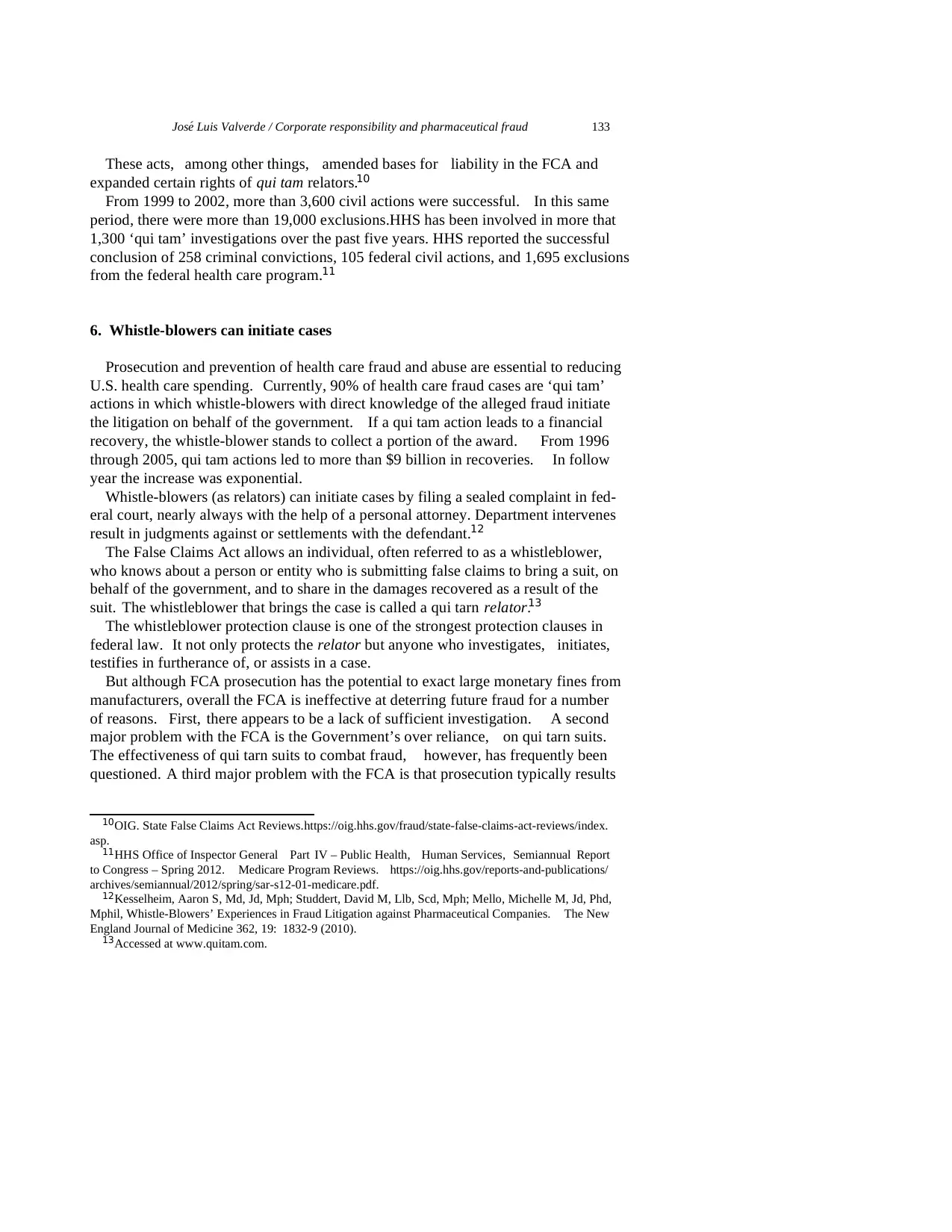
Jos´e Luis Valverde / Corporate responsibility and pharmaceutical fraud 133
These acts, among other things, amended bases for liability in the FCA and
expanded certain rights of qui tam relators.10
From 1999 to 2002, more than 3,600 civil actions were successful. In this same
period, there were more than 19,000 exclusions.HHS has been involved in more that
1,300 ‘qui tam’ investigations over the past five years. HHS reported the successful
conclusion of 258 criminal convictions, 105 federal civil actions, and 1,695 exclusions
from the federal health care program.11
6. Whistle-blowers can initiate cases
Prosecution and prevention of health care fraud and abuse are essential to reducing
U.S. health care spending. Currently, 90% of health care fraud cases are ‘qui tam’
actions in which whistle-blowers with direct knowledge of the alleged fraud initiate
the litigation on behalf of the government. If a qui tam action leads to a financial
recovery, the whistle-blower stands to collect a portion of the award. From 1996
through 2005, qui tam actions led to more than $9 billion in recoveries. In follow
year the increase was exponential.
Whistle-blowers (as relators) can initiate cases by filing a sealed complaint in fed-
eral court, nearly always with the help of a personal attorney. Department intervenes
result in judgments against or settlements with the defendant.12
The False Claims Act allows an individual, often referred to as a whistleblower,
who knows about a person or entity who is submitting false claims to bring a suit, on
behalf of the government, and to share in the damages recovered as a result of the
suit. The whistleblower that brings the case is called a qui tarn relator.13
The whistleblower protection clause is one of the strongest protection clauses in
federal law. It not only protects the relator but anyone who investigates, initiates,
testifies in furtherance of, or assists in a case.
But although FCA prosecution has the potential to exact large monetary fines from
manufacturers, overall the FCA is ineffective at deterring future fraud for a number
of reasons. First, there appears to be a lack of sufficient investigation. A second
major problem with the FCA is the Government’s over reliance, on qui tarn suits.
The effectiveness of qui tarn suits to combat fraud, however, has frequently been
questioned. A third major problem with the FCA is that prosecution typically results
10OIG. State False Claims Act Reviews.https://oig.hhs.gov/fraud/state-false-claims-act-reviews/index.
asp.
11HHS Office of Inspector General Part IV – Public Health, Human Services, Semiannual Report
to Congress – Spring 2012. Medicare Program Reviews. https://oig.hhs.gov/reports-and-publications/
archives/semiannual/2012/spring/sar-s12-01-medicare.pdf.
12Kesselheim, Aaron S, Md, Jd, Mph; Studdert, David M, Llb, Scd, Mph; Mello, Michelle M, Jd, Phd,
Mphil, Whistle-Blowers’ Experiences in Fraud Litigation against Pharmaceutical Companies. The New
England Journal of Medicine 362, 19: 1832-9 (2010).
13Accessed at www.quitam.com.
These acts, among other things, amended bases for liability in the FCA and
expanded certain rights of qui tam relators.10
From 1999 to 2002, more than 3,600 civil actions were successful. In this same
period, there were more than 19,000 exclusions.HHS has been involved in more that
1,300 ‘qui tam’ investigations over the past five years. HHS reported the successful
conclusion of 258 criminal convictions, 105 federal civil actions, and 1,695 exclusions
from the federal health care program.11
6. Whistle-blowers can initiate cases
Prosecution and prevention of health care fraud and abuse are essential to reducing
U.S. health care spending. Currently, 90% of health care fraud cases are ‘qui tam’
actions in which whistle-blowers with direct knowledge of the alleged fraud initiate
the litigation on behalf of the government. If a qui tam action leads to a financial
recovery, the whistle-blower stands to collect a portion of the award. From 1996
through 2005, qui tam actions led to more than $9 billion in recoveries. In follow
year the increase was exponential.
Whistle-blowers (as relators) can initiate cases by filing a sealed complaint in fed-
eral court, nearly always with the help of a personal attorney. Department intervenes
result in judgments against or settlements with the defendant.12
The False Claims Act allows an individual, often referred to as a whistleblower,
who knows about a person or entity who is submitting false claims to bring a suit, on
behalf of the government, and to share in the damages recovered as a result of the
suit. The whistleblower that brings the case is called a qui tarn relator.13
The whistleblower protection clause is one of the strongest protection clauses in
federal law. It not only protects the relator but anyone who investigates, initiates,
testifies in furtherance of, or assists in a case.
But although FCA prosecution has the potential to exact large monetary fines from
manufacturers, overall the FCA is ineffective at deterring future fraud for a number
of reasons. First, there appears to be a lack of sufficient investigation. A second
major problem with the FCA is the Government’s over reliance, on qui tarn suits.
The effectiveness of qui tarn suits to combat fraud, however, has frequently been
questioned. A third major problem with the FCA is that prosecution typically results
10OIG. State False Claims Act Reviews.https://oig.hhs.gov/fraud/state-false-claims-act-reviews/index.
asp.
11HHS Office of Inspector General Part IV – Public Health, Human Services, Semiannual Report
to Congress – Spring 2012. Medicare Program Reviews. https://oig.hhs.gov/reports-and-publications/
archives/semiannual/2012/spring/sar-s12-01-medicare.pdf.
12Kesselheim, Aaron S, Md, Jd, Mph; Studdert, David M, Llb, Scd, Mph; Mello, Michelle M, Jd, Phd,
Mphil, Whistle-Blowers’ Experiences in Fraud Litigation against Pharmaceutical Companies. The New
England Journal of Medicine 362, 19: 1832-9 (2010).
13Accessed at www.quitam.com.
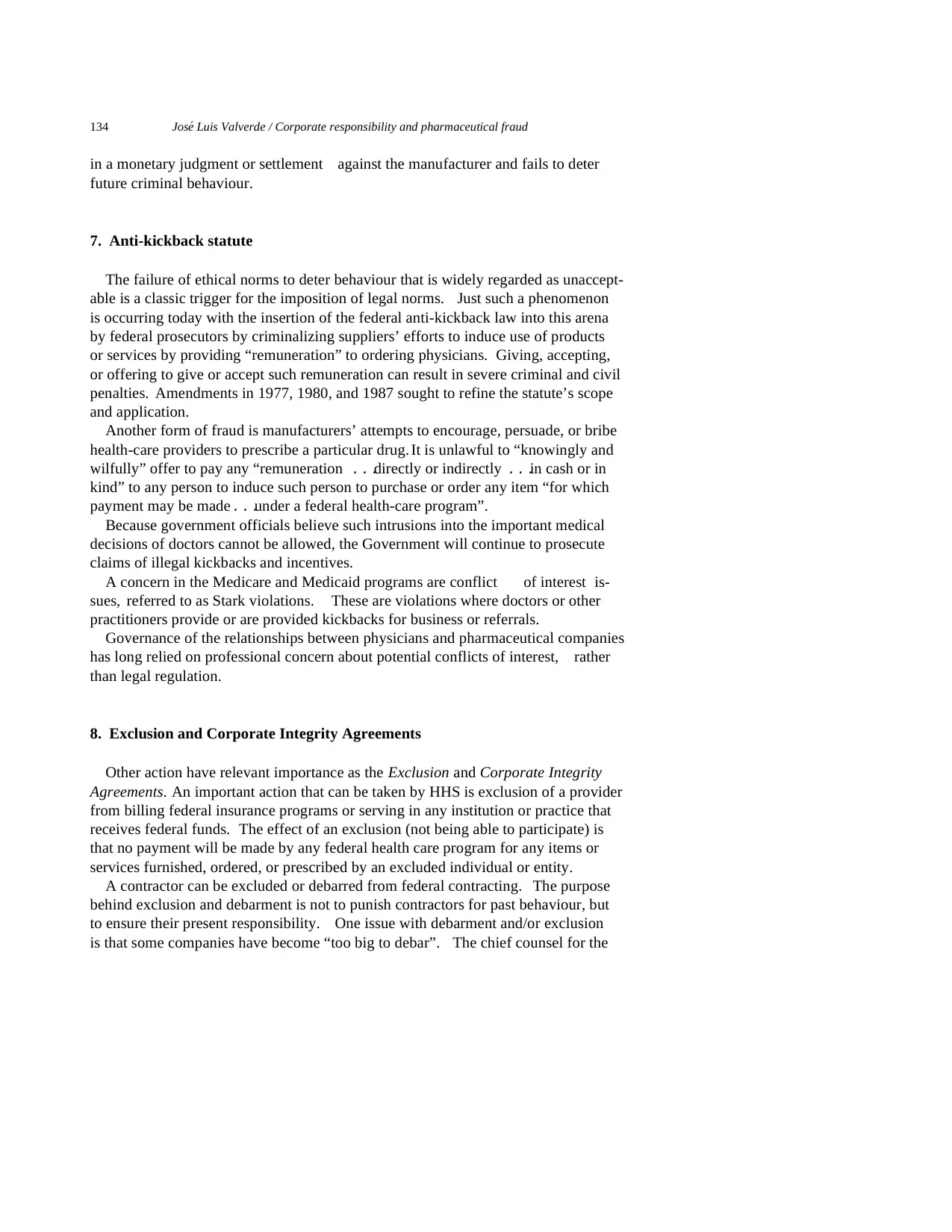
134 Jos´e Luis Valverde / Corporate responsibility and pharmaceutical fraud
in a monetary judgment or settlement against the manufacturer and fails to deter
future criminal behaviour.
7. Anti-kickback statute
The failure of ethical norms to deter behaviour that is widely regarded as unaccept-
able is a classic trigger for the imposition of legal norms. Just such a phenomenon
is occurring today with the insertion of the federal anti-kickback law into this arena
by federal prosecutors by criminalizing suppliers’ efforts to induce use of products
or services by providing “remuneration” to ordering physicians. Giving, accepting,
or offering to give or accept such remuneration can result in severe criminal and civil
penalties. Amendments in 1977, 1980, and 1987 sought to refine the statute’s scope
and application.
Another form of fraud is manufacturers’ attempts to encourage, persuade, or bribe
health-care providers to prescribe a particular drug. It is unlawful to “knowingly and
wilfully” offer to pay any “remuneration . . .directly or indirectly . . .in cash or in
kind” to any person to induce such person to purchase or order any item “for which
payment may be made . . .under a federal health-care program”.
Because government officials believe such intrusions into the important medical
decisions of doctors cannot be allowed, the Government will continue to prosecute
claims of illegal kickbacks and incentives.
A concern in the Medicare and Medicaid programs are conflict of interest is-
sues, referred to as Stark violations. These are violations where doctors or other
practitioners provide or are provided kickbacks for business or referrals.
Governance of the relationships between physicians and pharmaceutical companies
has long relied on professional concern about potential conflicts of interest, rather
than legal regulation.
8. Exclusion and Corporate Integrity Agreements
Other action have relevant importance as the Exclusion and Corporate Integrity
Agreements. An important action that can be taken by HHS is exclusion of a provider
from billing federal insurance programs or serving in any institution or practice that
receives federal funds. The effect of an exclusion (not being able to participate) is
that no payment will be made by any federal health care program for any items or
services furnished, ordered, or prescribed by an excluded individual or entity.
A contractor can be excluded or debarred from federal contracting. The purpose
behind exclusion and debarment is not to punish contractors for past behaviour, but
to ensure their present responsibility. One issue with debarment and/or exclusion
is that some companies have become “too big to debar”. The chief counsel for the
in a monetary judgment or settlement against the manufacturer and fails to deter
future criminal behaviour.
7. Anti-kickback statute
The failure of ethical norms to deter behaviour that is widely regarded as unaccept-
able is a classic trigger for the imposition of legal norms. Just such a phenomenon
is occurring today with the insertion of the federal anti-kickback law into this arena
by federal prosecutors by criminalizing suppliers’ efforts to induce use of products
or services by providing “remuneration” to ordering physicians. Giving, accepting,
or offering to give or accept such remuneration can result in severe criminal and civil
penalties. Amendments in 1977, 1980, and 1987 sought to refine the statute’s scope
and application.
Another form of fraud is manufacturers’ attempts to encourage, persuade, or bribe
health-care providers to prescribe a particular drug. It is unlawful to “knowingly and
wilfully” offer to pay any “remuneration . . .directly or indirectly . . .in cash or in
kind” to any person to induce such person to purchase or order any item “for which
payment may be made . . .under a federal health-care program”.
Because government officials believe such intrusions into the important medical
decisions of doctors cannot be allowed, the Government will continue to prosecute
claims of illegal kickbacks and incentives.
A concern in the Medicare and Medicaid programs are conflict of interest is-
sues, referred to as Stark violations. These are violations where doctors or other
practitioners provide or are provided kickbacks for business or referrals.
Governance of the relationships between physicians and pharmaceutical companies
has long relied on professional concern about potential conflicts of interest, rather
than legal regulation.
8. Exclusion and Corporate Integrity Agreements
Other action have relevant importance as the Exclusion and Corporate Integrity
Agreements. An important action that can be taken by HHS is exclusion of a provider
from billing federal insurance programs or serving in any institution or practice that
receives federal funds. The effect of an exclusion (not being able to participate) is
that no payment will be made by any federal health care program for any items or
services furnished, ordered, or prescribed by an excluded individual or entity.
A contractor can be excluded or debarred from federal contracting. The purpose
behind exclusion and debarment is not to punish contractors for past behaviour, but
to ensure their present responsibility. One issue with debarment and/or exclusion
is that some companies have become “too big to debar”. The chief counsel for the
⊘ This is a preview!⊘
Do you want full access?
Subscribe today to unlock all pages.

Trusted by 1+ million students worldwide
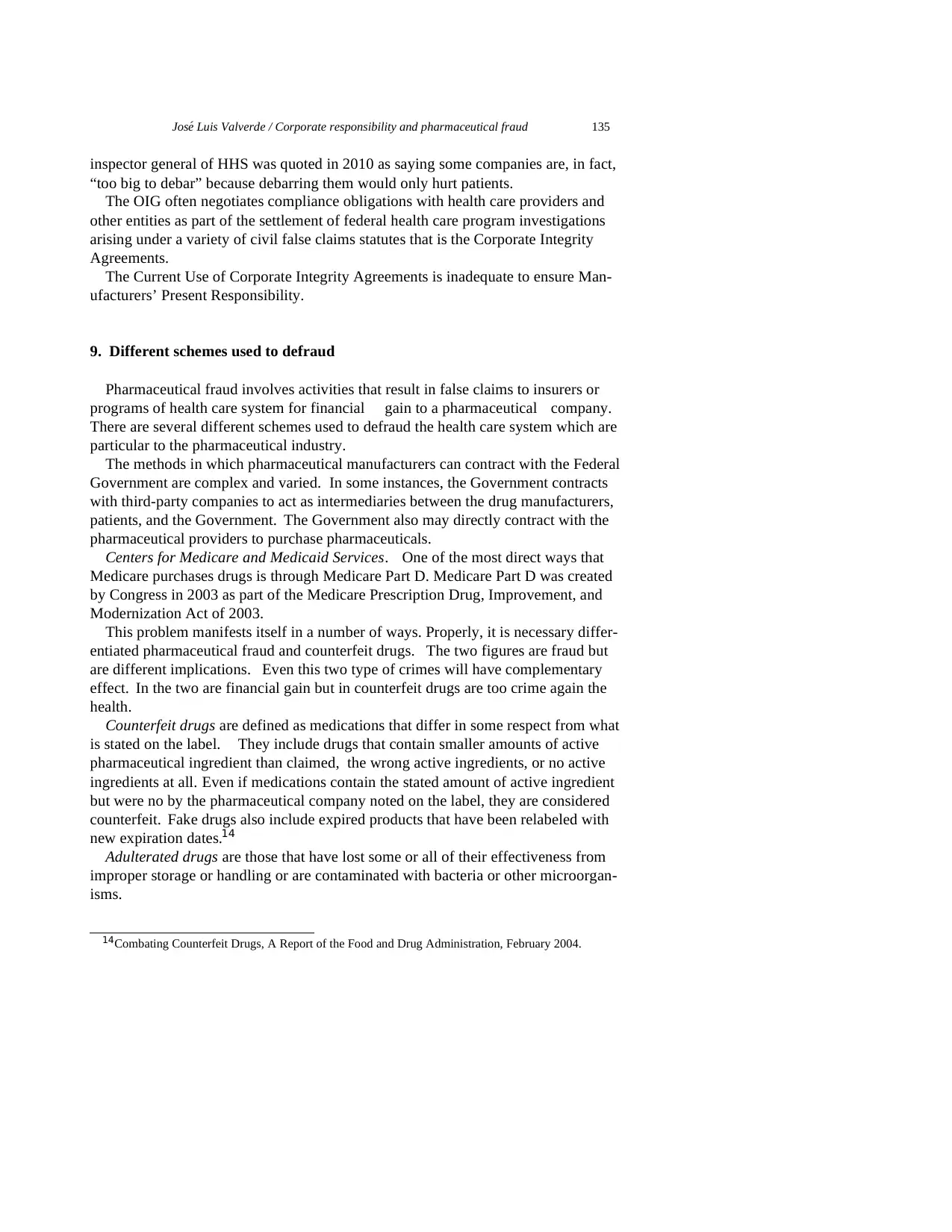
Jos´e Luis Valverde / Corporate responsibility and pharmaceutical fraud 135
inspector general of HHS was quoted in 2010 as saying some companies are, in fact,
“too big to debar” because debarring them would only hurt patients.
The OIG often negotiates compliance obligations with health care providers and
other entities as part of the settlement of federal health care program investigations
arising under a variety of civil false claims statutes that is the Corporate Integrity
Agreements.
The Current Use of Corporate Integrity Agreements is inadequate to ensure Man-
ufacturers’ Present Responsibility.
9. Different schemes used to defraud
Pharmaceutical fraud involves activities that result in false claims to insurers or
programs of health care system for financial gain to a pharmaceutical company.
There are several different schemes used to defraud the health care system which are
particular to the pharmaceutical industry.
The methods in which pharmaceutical manufacturers can contract with the Federal
Government are complex and varied. In some instances, the Government contracts
with third-party companies to act as intermediaries between the drug manufacturers,
patients, and the Government. The Government also may directly contract with the
pharmaceutical providers to purchase pharmaceuticals.
Centers for Medicare and Medicaid Services. One of the most direct ways that
Medicare purchases drugs is through Medicare Part D. Medicare Part D was created
by Congress in 2003 as part of the Medicare Prescription Drug, Improvement, and
Modernization Act of 2003.
This problem manifests itself in a number of ways. Properly, it is necessary differ-
entiated pharmaceutical fraud and counterfeit drugs. The two figures are fraud but
are different implications. Even this two type of crimes will have complementary
effect. In the two are financial gain but in counterfeit drugs are too crime again the
health.
Counterfeit drugs are defined as medications that differ in some respect from what
is stated on the label. They include drugs that contain smaller amounts of active
pharmaceutical ingredient than claimed, the wrong active ingredients, or no active
ingredients at all. Even if medications contain the stated amount of active ingredient
but were no by the pharmaceutical company noted on the label, they are considered
counterfeit. Fake drugs also include expired products that have been relabeled with
new expiration dates.14
Adulterated drugs are those that have lost some or all of their effectiveness from
improper storage or handling or are contaminated with bacteria or other microorgan-
isms.
14Combating Counterfeit Drugs, A Report of the Food and Drug Administration, February 2004.
inspector general of HHS was quoted in 2010 as saying some companies are, in fact,
“too big to debar” because debarring them would only hurt patients.
The OIG often negotiates compliance obligations with health care providers and
other entities as part of the settlement of federal health care program investigations
arising under a variety of civil false claims statutes that is the Corporate Integrity
Agreements.
The Current Use of Corporate Integrity Agreements is inadequate to ensure Man-
ufacturers’ Present Responsibility.
9. Different schemes used to defraud
Pharmaceutical fraud involves activities that result in false claims to insurers or
programs of health care system for financial gain to a pharmaceutical company.
There are several different schemes used to defraud the health care system which are
particular to the pharmaceutical industry.
The methods in which pharmaceutical manufacturers can contract with the Federal
Government are complex and varied. In some instances, the Government contracts
with third-party companies to act as intermediaries between the drug manufacturers,
patients, and the Government. The Government also may directly contract with the
pharmaceutical providers to purchase pharmaceuticals.
Centers for Medicare and Medicaid Services. One of the most direct ways that
Medicare purchases drugs is through Medicare Part D. Medicare Part D was created
by Congress in 2003 as part of the Medicare Prescription Drug, Improvement, and
Modernization Act of 2003.
This problem manifests itself in a number of ways. Properly, it is necessary differ-
entiated pharmaceutical fraud and counterfeit drugs. The two figures are fraud but
are different implications. Even this two type of crimes will have complementary
effect. In the two are financial gain but in counterfeit drugs are too crime again the
health.
Counterfeit drugs are defined as medications that differ in some respect from what
is stated on the label. They include drugs that contain smaller amounts of active
pharmaceutical ingredient than claimed, the wrong active ingredients, or no active
ingredients at all. Even if medications contain the stated amount of active ingredient
but were no by the pharmaceutical company noted on the label, they are considered
counterfeit. Fake drugs also include expired products that have been relabeled with
new expiration dates.14
Adulterated drugs are those that have lost some or all of their effectiveness from
improper storage or handling or are contaminated with bacteria or other microorgan-
isms.
14Combating Counterfeit Drugs, A Report of the Food and Drug Administration, February 2004.
Paraphrase This Document
Need a fresh take? Get an instant paraphrase of this document with our AI Paraphraser

136 Jos´e Luis Valverde / Corporate responsibility and pharmaceutical fraud
Some of the drugs that have been particular targets of counterfeiters are expensive
products designed for the sickest patients. The FDA had reported, for example,
counterfeit Procrit, an antianemia drug, placed at risk patients severely ill with
cancer and AIDS, and counterfeit Epogen caused grave medical complications for
organ transplant recipients and patients with end-stage kidney disease. Lipitor, a
widely prescribed medicine for lowering cholesterol.
In USA some pharmacies that supply nursing homes and hospices knowingly and
fraudulently order at discounted prices far more drugs than they can use, then sell the
excess to shady wholesalers at a profit.
In addition, some pharmacies that compound drugs for patients with special needs
create formulations that are seriously subpotent, that is, they contain less of the active
ingredient than indicated on the label. These problems of drug diversion exist all
over the country.
10. Fraud from the wholesalers
In the U.S., there are three large drug wholesalers – AmerisourceBergen, Cardinal
Health, and McKesson – and an estimated 7,000 smaller, secondary wholesalers.All
wholesalers are regulated by the states. The three large wholesalers handle 90% of
the drugs in this country. They buy most of them directly from manufacturers and sell
to retail pharmacies, hospitals, nursing homes, and hospices. They purchase drugs
for resale to retail pharmacies at one price, and drugs for resale to hospitals, nursing
homes, and hospices at discounted prices – on average 40% lower. Over the years,
inspectors had always assumed that drug wholesalers were running their businesses
properly and therefore performed few inspections. An alarming percentage of the
drugs in wholesale market had been illegally acquired or illegally imported from
overseas.
In 2003 The National Association of Boards of Pharmacy develop model legislation
for the states that would help eliminate corruption among drug wholesalers and min-
imize the chances that wholesalers would purchase from counterfeiters. The States
license wholesalers, yet many lack the resources to verify whether the wholesalers
are handling drugs properly or engaging in fraudulent behaviour.
Experts have a variety of opinions on how to eliminate corruption in the wholesale
industry. Some says that one part of the solution is to mandate “strict liability for
those who sell a counterfeit or adulterated drug regardless of whether they knew about
it. By instituting very strong financial disincentives for selling counterfeit drugs, you
in effect force manufacturers and wholesalers to pick their own methods of security
and safety”.15
15B. Hileman, Counterfeit drugs, Cenear 81, 45: 36-43 (2003).
Some of the drugs that have been particular targets of counterfeiters are expensive
products designed for the sickest patients. The FDA had reported, for example,
counterfeit Procrit, an antianemia drug, placed at risk patients severely ill with
cancer and AIDS, and counterfeit Epogen caused grave medical complications for
organ transplant recipients and patients with end-stage kidney disease. Lipitor, a
widely prescribed medicine for lowering cholesterol.
In USA some pharmacies that supply nursing homes and hospices knowingly and
fraudulently order at discounted prices far more drugs than they can use, then sell the
excess to shady wholesalers at a profit.
In addition, some pharmacies that compound drugs for patients with special needs
create formulations that are seriously subpotent, that is, they contain less of the active
ingredient than indicated on the label. These problems of drug diversion exist all
over the country.
10. Fraud from the wholesalers
In the U.S., there are three large drug wholesalers – AmerisourceBergen, Cardinal
Health, and McKesson – and an estimated 7,000 smaller, secondary wholesalers.All
wholesalers are regulated by the states. The three large wholesalers handle 90% of
the drugs in this country. They buy most of them directly from manufacturers and sell
to retail pharmacies, hospitals, nursing homes, and hospices. They purchase drugs
for resale to retail pharmacies at one price, and drugs for resale to hospitals, nursing
homes, and hospices at discounted prices – on average 40% lower. Over the years,
inspectors had always assumed that drug wholesalers were running their businesses
properly and therefore performed few inspections. An alarming percentage of the
drugs in wholesale market had been illegally acquired or illegally imported from
overseas.
In 2003 The National Association of Boards of Pharmacy develop model legislation
for the states that would help eliminate corruption among drug wholesalers and min-
imize the chances that wholesalers would purchase from counterfeiters. The States
license wholesalers, yet many lack the resources to verify whether the wholesalers
are handling drugs properly or engaging in fraudulent behaviour.
Experts have a variety of opinions on how to eliminate corruption in the wholesale
industry. Some says that one part of the solution is to mandate “strict liability for
those who sell a counterfeit or adulterated drug regardless of whether they knew about
it. By instituting very strong financial disincentives for selling counterfeit drugs, you
in effect force manufacturers and wholesalers to pick their own methods of security
and safety”.15
15B. Hileman, Counterfeit drugs, Cenear 81, 45: 36-43 (2003).
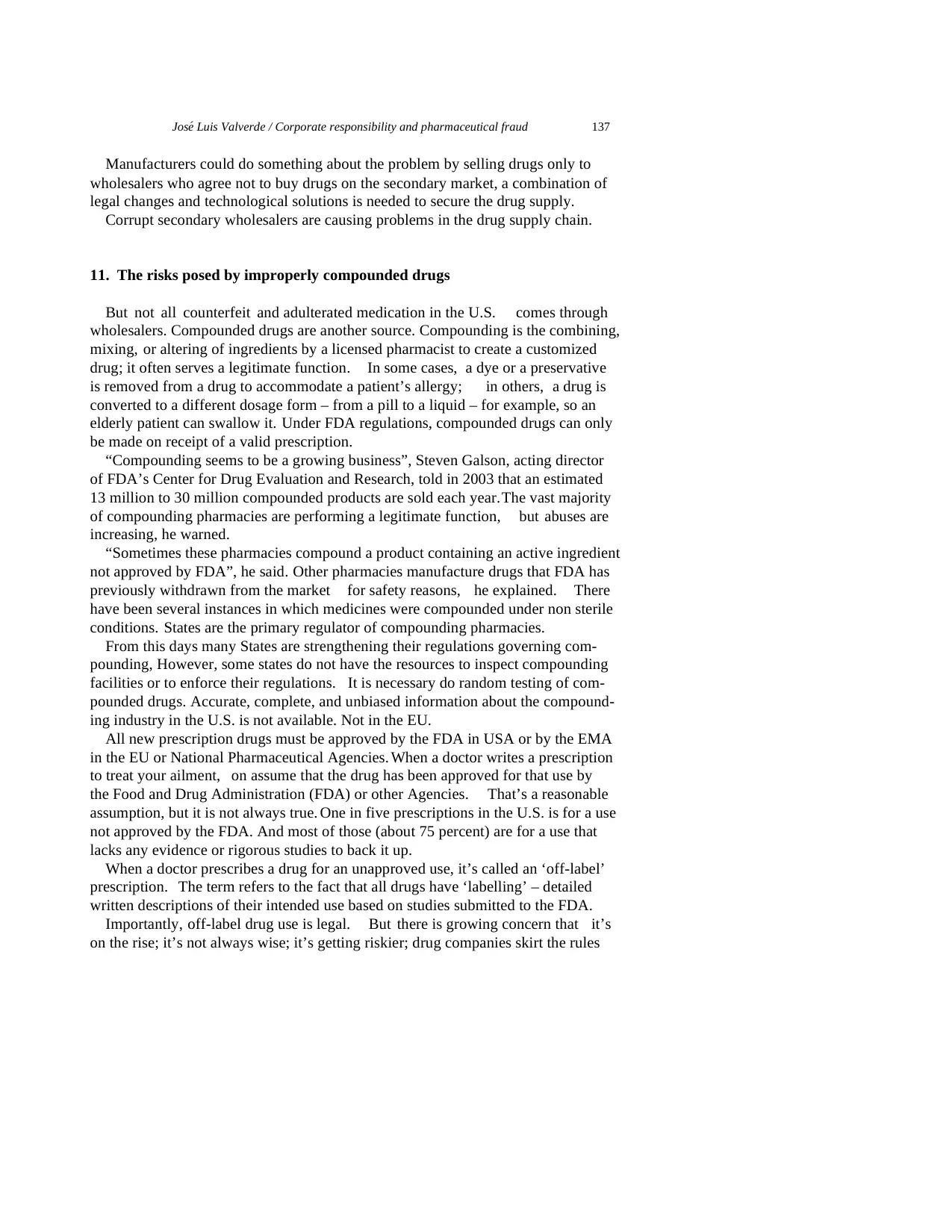
Jos´e Luis Valverde / Corporate responsibility and pharmaceutical fraud 137
Manufacturers could do something about the problem by selling drugs only to
wholesalers who agree not to buy drugs on the secondary market, a combination of
legal changes and technological solutions is needed to secure the drug supply.
Corrupt secondary wholesalers are causing problems in the drug supply chain.
11. The risks posed by improperly compounded drugs
But not all counterfeit and adulterated medication in the U.S. comes through
wholesalers. Compounded drugs are another source. Compounding is the combining,
mixing, or altering of ingredients by a licensed pharmacist to create a customized
drug; it often serves a legitimate function. In some cases, a dye or a preservative
is removed from a drug to accommodate a patient’s allergy; in others, a drug is
converted to a different dosage form – from a pill to a liquid – for example, so an
elderly patient can swallow it. Under FDA regulations, compounded drugs can only
be made on receipt of a valid prescription.
“Compounding seems to be a growing business”, Steven Galson, acting director
of FDA’s Center for Drug Evaluation and Research, told in 2003 that an estimated
13 million to 30 million compounded products are sold each year.The vast majority
of compounding pharmacies are performing a legitimate function, but abuses are
increasing, he warned.
“Sometimes these pharmacies compound a product containing an active ingredient
not approved by FDA”, he said. Other pharmacies manufacture drugs that FDA has
previously withdrawn from the market for safety reasons, he explained. There
have been several instances in which medicines were compounded under non sterile
conditions. States are the primary regulator of compounding pharmacies.
From this days many States are strengthening their regulations governing com-
pounding, However, some states do not have the resources to inspect compounding
facilities or to enforce their regulations. It is necessary do random testing of com-
pounded drugs. Accurate, complete, and unbiased information about the compound-
ing industry in the U.S. is not available. Not in the EU.
All new prescription drugs must be approved by the FDA in USA or by the EMA
in the EU or National Pharmaceutical Agencies. When a doctor writes a prescription
to treat your ailment, on assume that the drug has been approved for that use by
the Food and Drug Administration (FDA) or other Agencies. That’s a reasonable
assumption, but it is not always true. One in five prescriptions in the U.S. is for a use
not approved by the FDA. And most of those (about 75 percent) are for a use that
lacks any evidence or rigorous studies to back it up.
When a doctor prescribes a drug for an unapproved use, it’s called an ‘off-label’
prescription. The term refers to the fact that all drugs have ‘labelling’ – detailed
written descriptions of their intended use based on studies submitted to the FDA.
Importantly, off-label drug use is legal. But there is growing concern that it’s
on the rise; it’s not always wise; it’s getting riskier; drug companies skirt the rules
Manufacturers could do something about the problem by selling drugs only to
wholesalers who agree not to buy drugs on the secondary market, a combination of
legal changes and technological solutions is needed to secure the drug supply.
Corrupt secondary wholesalers are causing problems in the drug supply chain.
11. The risks posed by improperly compounded drugs
But not all counterfeit and adulterated medication in the U.S. comes through
wholesalers. Compounded drugs are another source. Compounding is the combining,
mixing, or altering of ingredients by a licensed pharmacist to create a customized
drug; it often serves a legitimate function. In some cases, a dye or a preservative
is removed from a drug to accommodate a patient’s allergy; in others, a drug is
converted to a different dosage form – from a pill to a liquid – for example, so an
elderly patient can swallow it. Under FDA regulations, compounded drugs can only
be made on receipt of a valid prescription.
“Compounding seems to be a growing business”, Steven Galson, acting director
of FDA’s Center for Drug Evaluation and Research, told in 2003 that an estimated
13 million to 30 million compounded products are sold each year.The vast majority
of compounding pharmacies are performing a legitimate function, but abuses are
increasing, he warned.
“Sometimes these pharmacies compound a product containing an active ingredient
not approved by FDA”, he said. Other pharmacies manufacture drugs that FDA has
previously withdrawn from the market for safety reasons, he explained. There
have been several instances in which medicines were compounded under non sterile
conditions. States are the primary regulator of compounding pharmacies.
From this days many States are strengthening their regulations governing com-
pounding, However, some states do not have the resources to inspect compounding
facilities or to enforce their regulations. It is necessary do random testing of com-
pounded drugs. Accurate, complete, and unbiased information about the compound-
ing industry in the U.S. is not available. Not in the EU.
All new prescription drugs must be approved by the FDA in USA or by the EMA
in the EU or National Pharmaceutical Agencies. When a doctor writes a prescription
to treat your ailment, on assume that the drug has been approved for that use by
the Food and Drug Administration (FDA) or other Agencies. That’s a reasonable
assumption, but it is not always true. One in five prescriptions in the U.S. is for a use
not approved by the FDA. And most of those (about 75 percent) are for a use that
lacks any evidence or rigorous studies to back it up.
When a doctor prescribes a drug for an unapproved use, it’s called an ‘off-label’
prescription. The term refers to the fact that all drugs have ‘labelling’ – detailed
written descriptions of their intended use based on studies submitted to the FDA.
Importantly, off-label drug use is legal. But there is growing concern that it’s
on the rise; it’s not always wise; it’s getting riskier; drug companies skirt the rules
⊘ This is a preview!⊘
Do you want full access?
Subscribe today to unlock all pages.

Trusted by 1+ million students worldwide
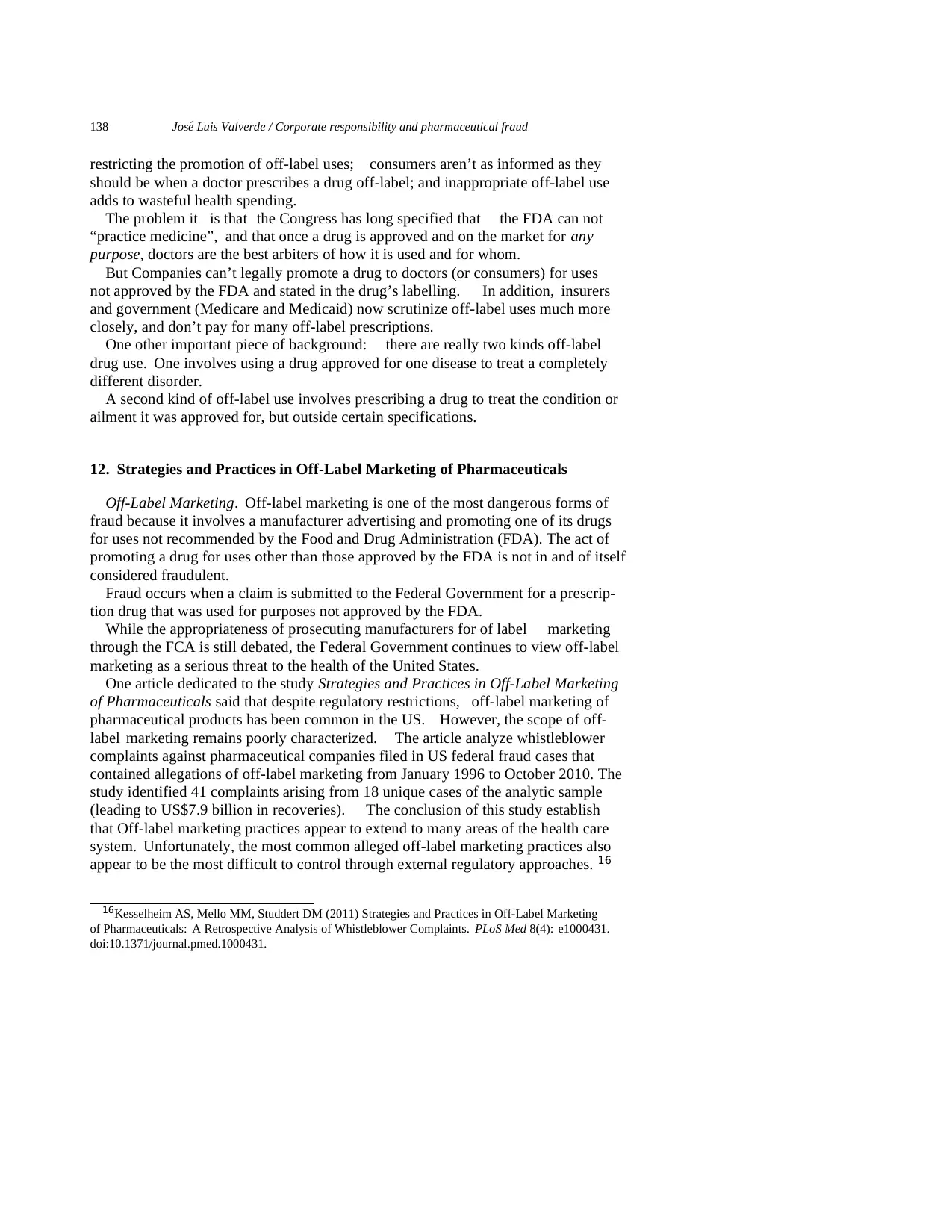
138 Jos´e Luis Valverde / Corporate responsibility and pharmaceutical fraud
restricting the promotion of off-label uses; consumers aren’t as informed as they
should be when a doctor prescribes a drug off-label; and inappropriate off-label use
adds to wasteful health spending.
The problem it is that the Congress has long specified that the FDA can not
“practice medicine”, and that once a drug is approved and on the market for any
purpose, doctors are the best arbiters of how it is used and for whom.
But Companies can’t legally promote a drug to doctors (or consumers) for uses
not approved by the FDA and stated in the drug’s labelling. In addition, insurers
and government (Medicare and Medicaid) now scrutinize off-label uses much more
closely, and don’t pay for many off-label prescriptions.
One other important piece of background: there are really two kinds off-label
drug use. One involves using a drug approved for one disease to treat a completely
different disorder.
A second kind of off-label use involves prescribing a drug to treat the condition or
ailment it was approved for, but outside certain specifications.
12. Strategies and Practices in Off-Label Marketing of Pharmaceuticals
Off-Label Marketing. Off-label marketing is one of the most dangerous forms of
fraud because it involves a manufacturer advertising and promoting one of its drugs
for uses not recommended by the Food and Drug Administration (FDA). The act of
promoting a drug for uses other than those approved by the FDA is not in and of itself
considered fraudulent.
Fraud occurs when a claim is submitted to the Federal Government for a prescrip-
tion drug that was used for purposes not approved by the FDA.
While the appropriateness of prosecuting manufacturers for of label marketing
through the FCA is still debated, the Federal Government continues to view off-label
marketing as a serious threat to the health of the United States.
One article dedicated to the study Strategies and Practices in Off-Label Marketing
of Pharmaceuticals said that despite regulatory restrictions, off-label marketing of
pharmaceutical products has been common in the US. However, the scope of off-
label marketing remains poorly characterized. The article analyze whistleblower
complaints against pharmaceutical companies filed in US federal fraud cases that
contained allegations of off-label marketing from January 1996 to October 2010. The
study identified 41 complaints arising from 18 unique cases of the analytic sample
(leading to US$7.9 billion in recoveries). The conclusion of this study establish
that Off-label marketing practices appear to extend to many areas of the health care
system. Unfortunately, the most common alleged off-label marketing practices also
appear to be the most difficult to control through external regulatory approaches. 16
16Kesselheim AS, Mello MM, Studdert DM (2011) Strategies and Practices in Off-Label Marketing
of Pharmaceuticals: A Retrospective Analysis of Whistleblower Complaints. PLoS Med 8(4): e1000431.
doi:10.1371/journal.pmed.1000431.
restricting the promotion of off-label uses; consumers aren’t as informed as they
should be when a doctor prescribes a drug off-label; and inappropriate off-label use
adds to wasteful health spending.
The problem it is that the Congress has long specified that the FDA can not
“practice medicine”, and that once a drug is approved and on the market for any
purpose, doctors are the best arbiters of how it is used and for whom.
But Companies can’t legally promote a drug to doctors (or consumers) for uses
not approved by the FDA and stated in the drug’s labelling. In addition, insurers
and government (Medicare and Medicaid) now scrutinize off-label uses much more
closely, and don’t pay for many off-label prescriptions.
One other important piece of background: there are really two kinds off-label
drug use. One involves using a drug approved for one disease to treat a completely
different disorder.
A second kind of off-label use involves prescribing a drug to treat the condition or
ailment it was approved for, but outside certain specifications.
12. Strategies and Practices in Off-Label Marketing of Pharmaceuticals
Off-Label Marketing. Off-label marketing is one of the most dangerous forms of
fraud because it involves a manufacturer advertising and promoting one of its drugs
for uses not recommended by the Food and Drug Administration (FDA). The act of
promoting a drug for uses other than those approved by the FDA is not in and of itself
considered fraudulent.
Fraud occurs when a claim is submitted to the Federal Government for a prescrip-
tion drug that was used for purposes not approved by the FDA.
While the appropriateness of prosecuting manufacturers for of label marketing
through the FCA is still debated, the Federal Government continues to view off-label
marketing as a serious threat to the health of the United States.
One article dedicated to the study Strategies and Practices in Off-Label Marketing
of Pharmaceuticals said that despite regulatory restrictions, off-label marketing of
pharmaceutical products has been common in the US. However, the scope of off-
label marketing remains poorly characterized. The article analyze whistleblower
complaints against pharmaceutical companies filed in US federal fraud cases that
contained allegations of off-label marketing from January 1996 to October 2010. The
study identified 41 complaints arising from 18 unique cases of the analytic sample
(leading to US$7.9 billion in recoveries). The conclusion of this study establish
that Off-label marketing practices appear to extend to many areas of the health care
system. Unfortunately, the most common alleged off-label marketing practices also
appear to be the most difficult to control through external regulatory approaches. 16
16Kesselheim AS, Mello MM, Studdert DM (2011) Strategies and Practices in Off-Label Marketing
of Pharmaceuticals: A Retrospective Analysis of Whistleblower Complaints. PLoS Med 8(4): e1000431.
doi:10.1371/journal.pmed.1000431.
Paraphrase This Document
Need a fresh take? Get an instant paraphrase of this document with our AI Paraphraser
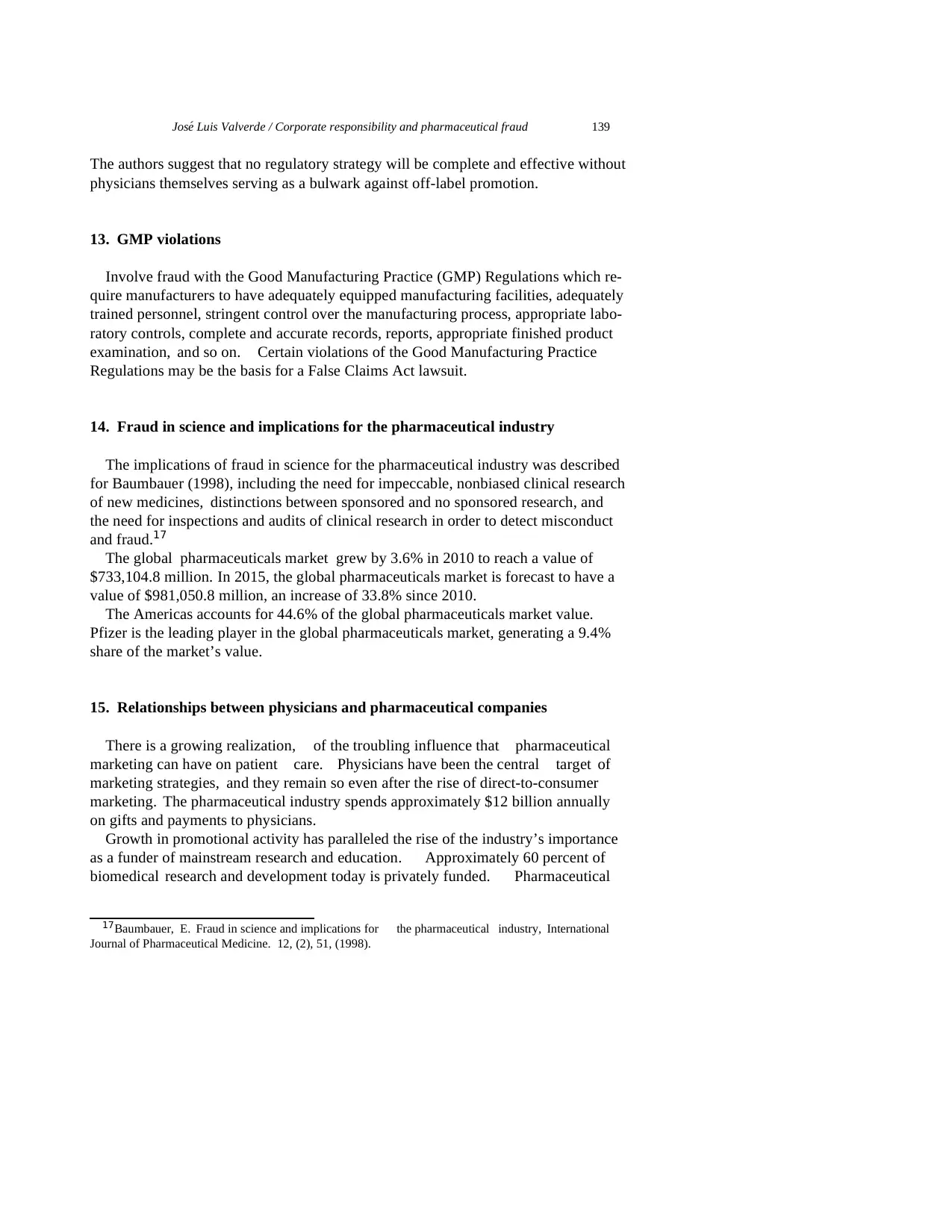
Jos´e Luis Valverde / Corporate responsibility and pharmaceutical fraud 139
The authors suggest that no regulatory strategy will be complete and effective without
physicians themselves serving as a bulwark against off-label promotion.
13. GMP violations
Involve fraud with the Good Manufacturing Practice (GMP) Regulations which re-
quire manufacturers to have adequately equipped manufacturing facilities, adequately
trained personnel, stringent control over the manufacturing process, appropriate labo-
ratory controls, complete and accurate records, reports, appropriate finished product
examination, and so on. Certain violations of the Good Manufacturing Practice
Regulations may be the basis for a False Claims Act lawsuit.
14. Fraud in science and implications for the pharmaceutical industry
The implications of fraud in science for the pharmaceutical industry was described
for Baumbauer (1998), including the need for impeccable, nonbiased clinical research
of new medicines, distinctions between sponsored and no sponsored research, and
the need for inspections and audits of clinical research in order to detect misconduct
and fraud.17
The global pharmaceuticals market grew by 3.6% in 2010 to reach a value of
$733,104.8 million. In 2015, the global pharmaceuticals market is forecast to have a
value of $981,050.8 million, an increase of 33.8% since 2010.
The Americas accounts for 44.6% of the global pharmaceuticals market value.
Pfizer is the leading player in the global pharmaceuticals market, generating a 9.4%
share of the market’s value.
15. Relationships between physicians and pharmaceutical companies
There is a growing realization, of the troubling influence that pharmaceutical
marketing can have on patient care. Physicians have been the central target of
marketing strategies, and they remain so even after the rise of direct-to-consumer
marketing. The pharmaceutical industry spends approximately $12 billion annually
on gifts and payments to physicians.
Growth in promotional activity has paralleled the rise of the industry’s importance
as a funder of mainstream research and education. Approximately 60 percent of
biomedical research and development today is privately funded. Pharmaceutical
17Baumbauer, E. Fraud in science and implications for the pharmaceutical industry, International
Journal of Pharmaceutical Medicine. 12, (2), 51, (1998).
The authors suggest that no regulatory strategy will be complete and effective without
physicians themselves serving as a bulwark against off-label promotion.
13. GMP violations
Involve fraud with the Good Manufacturing Practice (GMP) Regulations which re-
quire manufacturers to have adequately equipped manufacturing facilities, adequately
trained personnel, stringent control over the manufacturing process, appropriate labo-
ratory controls, complete and accurate records, reports, appropriate finished product
examination, and so on. Certain violations of the Good Manufacturing Practice
Regulations may be the basis for a False Claims Act lawsuit.
14. Fraud in science and implications for the pharmaceutical industry
The implications of fraud in science for the pharmaceutical industry was described
for Baumbauer (1998), including the need for impeccable, nonbiased clinical research
of new medicines, distinctions between sponsored and no sponsored research, and
the need for inspections and audits of clinical research in order to detect misconduct
and fraud.17
The global pharmaceuticals market grew by 3.6% in 2010 to reach a value of
$733,104.8 million. In 2015, the global pharmaceuticals market is forecast to have a
value of $981,050.8 million, an increase of 33.8% since 2010.
The Americas accounts for 44.6% of the global pharmaceuticals market value.
Pfizer is the leading player in the global pharmaceuticals market, generating a 9.4%
share of the market’s value.
15. Relationships between physicians and pharmaceutical companies
There is a growing realization, of the troubling influence that pharmaceutical
marketing can have on patient care. Physicians have been the central target of
marketing strategies, and they remain so even after the rise of direct-to-consumer
marketing. The pharmaceutical industry spends approximately $12 billion annually
on gifts and payments to physicians.
Growth in promotional activity has paralleled the rise of the industry’s importance
as a funder of mainstream research and education. Approximately 60 percent of
biomedical research and development today is privately funded. Pharmaceutical
17Baumbauer, E. Fraud in science and implications for the pharmaceutical industry, International
Journal of Pharmaceutical Medicine. 12, (2), 51, (1998).
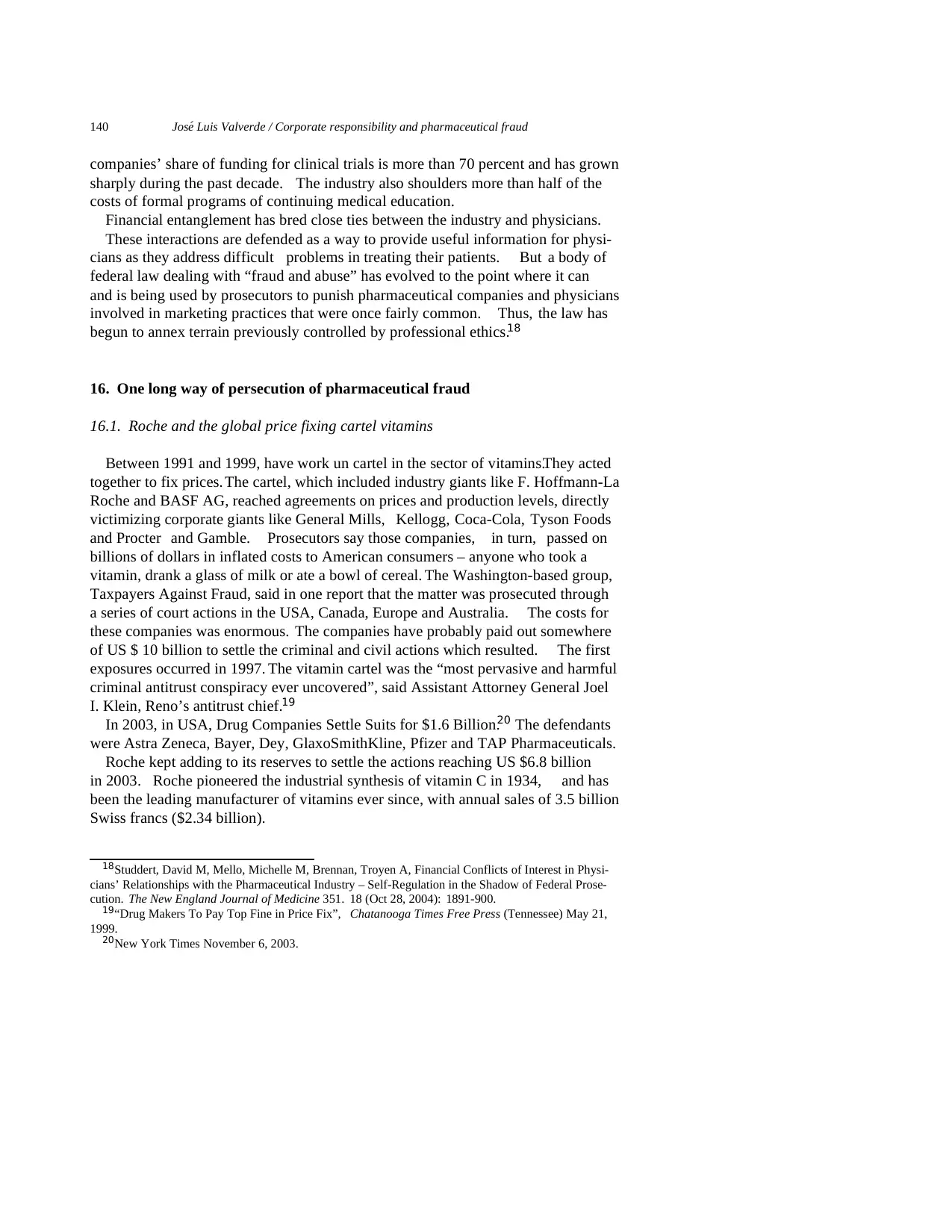
140 Jos´e Luis Valverde / Corporate responsibility and pharmaceutical fraud
companies’ share of funding for clinical trials is more than 70 percent and has grown
sharply during the past decade. The industry also shoulders more than half of the
costs of formal programs of continuing medical education.
Financial entanglement has bred close ties between the industry and physicians.
These interactions are defended as a way to provide useful information for physi-
cians as they address difficult problems in treating their patients. But a body of
federal law dealing with “fraud and abuse” has evolved to the point where it can
and is being used by prosecutors to punish pharmaceutical companies and physicians
involved in marketing practices that were once fairly common. Thus, the law has
begun to annex terrain previously controlled by professional ethics.18
16. One long way of persecution of pharmaceutical fraud
16.1. Roche and the global price fixing cartel vitamins
Between 1991 and 1999, have work un cartel in the sector of vitamins.They acted
together to fix prices. The cartel, which included industry giants like F. Hoffmann-La
Roche and BASF AG, reached agreements on prices and production levels, directly
victimizing corporate giants like General Mills, Kellogg, Coca-Cola, Tyson Foods
and Procter and Gamble. Prosecutors say those companies, in turn, passed on
billions of dollars in inflated costs to American consumers – anyone who took a
vitamin, drank a glass of milk or ate a bowl of cereal. The Washington-based group,
Taxpayers Against Fraud, said in one report that the matter was prosecuted through
a series of court actions in the USA, Canada, Europe and Australia. The costs for
these companies was enormous. The companies have probably paid out somewhere
of US $ 10 billion to settle the criminal and civil actions which resulted. The first
exposures occurred in 1997. The vitamin cartel was the “most pervasive and harmful
criminal antitrust conspiracy ever uncovered”, said Assistant Attorney General Joel
I. Klein, Reno’s antitrust chief.19
In 2003, in USA, Drug Companies Settle Suits for $1.6 Billion.20 The defendants
were Astra Zeneca, Bayer, Dey, GlaxoSmithKline, Pfizer and TAP Pharmaceuticals.
Roche kept adding to its reserves to settle the actions reaching US $6.8 billion
in 2003. Roche pioneered the industrial synthesis of vitamin C in 1934, and has
been the leading manufacturer of vitamins ever since, with annual sales of 3.5 billion
Swiss francs ($2.34 billion).
18Studdert, David M, Mello, Michelle M, Brennan, Troyen A, Financial Conflicts of Interest in Physi-
cians’ Relationships with the Pharmaceutical Industry – Self-Regulation in the Shadow of Federal Prose-
cution. The New England Journal of Medicine 351. 18 (Oct 28, 2004): 1891-900.
19“Drug Makers To Pay Top Fine in Price Fix”, Chatanooga Times Free Press (Tennessee) May 21,
1999.
20New York Times November 6, 2003.
companies’ share of funding for clinical trials is more than 70 percent and has grown
sharply during the past decade. The industry also shoulders more than half of the
costs of formal programs of continuing medical education.
Financial entanglement has bred close ties between the industry and physicians.
These interactions are defended as a way to provide useful information for physi-
cians as they address difficult problems in treating their patients. But a body of
federal law dealing with “fraud and abuse” has evolved to the point where it can
and is being used by prosecutors to punish pharmaceutical companies and physicians
involved in marketing practices that were once fairly common. Thus, the law has
begun to annex terrain previously controlled by professional ethics.18
16. One long way of persecution of pharmaceutical fraud
16.1. Roche and the global price fixing cartel vitamins
Between 1991 and 1999, have work un cartel in the sector of vitamins.They acted
together to fix prices. The cartel, which included industry giants like F. Hoffmann-La
Roche and BASF AG, reached agreements on prices and production levels, directly
victimizing corporate giants like General Mills, Kellogg, Coca-Cola, Tyson Foods
and Procter and Gamble. Prosecutors say those companies, in turn, passed on
billions of dollars in inflated costs to American consumers – anyone who took a
vitamin, drank a glass of milk or ate a bowl of cereal. The Washington-based group,
Taxpayers Against Fraud, said in one report that the matter was prosecuted through
a series of court actions in the USA, Canada, Europe and Australia. The costs for
these companies was enormous. The companies have probably paid out somewhere
of US $ 10 billion to settle the criminal and civil actions which resulted. The first
exposures occurred in 1997. The vitamin cartel was the “most pervasive and harmful
criminal antitrust conspiracy ever uncovered”, said Assistant Attorney General Joel
I. Klein, Reno’s antitrust chief.19
In 2003, in USA, Drug Companies Settle Suits for $1.6 Billion.20 The defendants
were Astra Zeneca, Bayer, Dey, GlaxoSmithKline, Pfizer and TAP Pharmaceuticals.
Roche kept adding to its reserves to settle the actions reaching US $6.8 billion
in 2003. Roche pioneered the industrial synthesis of vitamin C in 1934, and has
been the leading manufacturer of vitamins ever since, with annual sales of 3.5 billion
Swiss francs ($2.34 billion).
18Studdert, David M, Mello, Michelle M, Brennan, Troyen A, Financial Conflicts of Interest in Physi-
cians’ Relationships with the Pharmaceutical Industry – Self-Regulation in the Shadow of Federal Prose-
cution. The New England Journal of Medicine 351. 18 (Oct 28, 2004): 1891-900.
19“Drug Makers To Pay Top Fine in Price Fix”, Chatanooga Times Free Press (Tennessee) May 21,
1999.
20New York Times November 6, 2003.
⊘ This is a preview!⊘
Do you want full access?
Subscribe today to unlock all pages.

Trusted by 1+ million students worldwide
1 out of 29
Your All-in-One AI-Powered Toolkit for Academic Success.
+13062052269
info@desklib.com
Available 24*7 on WhatsApp / Email
![[object Object]](/_next/static/media/star-bottom.7253800d.svg)
Unlock your academic potential
Copyright © 2020–2025 A2Z Services. All Rights Reserved. Developed and managed by ZUCOL.